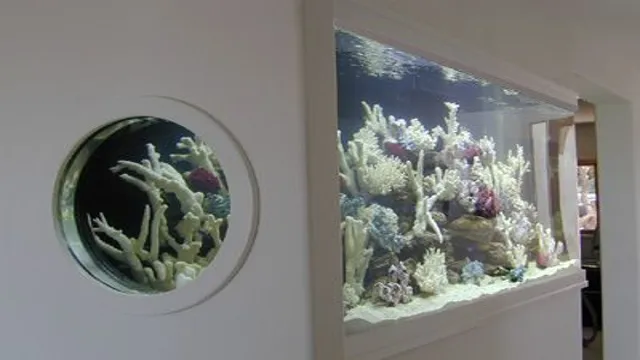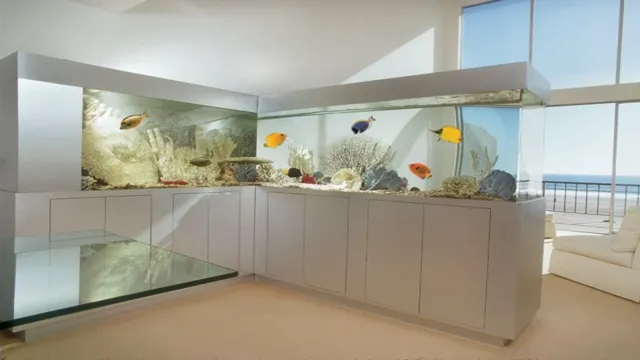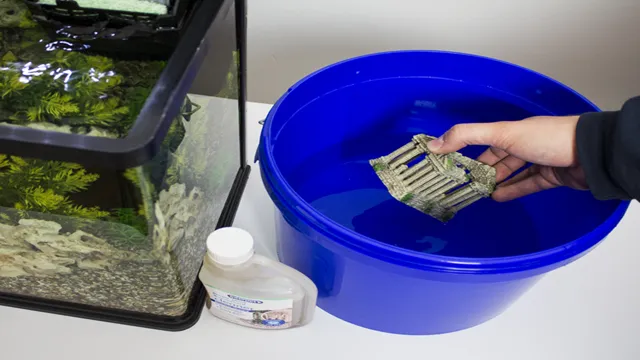Aquariums come in different shapes and sizes, making it a fun and exciting hobby for many. However, it can be quite tricky when it comes to measuring the number of gallons needed to fill an L-shaped aquarium. It’s essential to determine the correct gallons for your aquarium because it affects the proper maintenance of the aquarium and the health of your aquatic pets.
In this blog post, we’ll discuss ways to calculate the gallons in your L-shaped aquarium, including necessary tools and formulas. Whether you’re starting or already have an L-shaped aquarium, stick with us and learn the best method to calculate your aquarium’s size. Let’s dive in!
Understanding the Shape of Your Aquarium
If you have an L-shaped aquarium, determining its gallon size might seem like a complicated task, but with a few simple calculations, you can get an accurate estimate. Start by measuring the length, width, and height of each section of the aquarium in inches. Then, multiply the length, width, and height together to get the cubic inches for each section.
Next, add the cubic inches for each section together, and divide the total by 231 (the number of cubic inches in one gallon) to get the total gallons of your L-shaped aquarium. Remember, it’s better to measure each section separately because they might differ in size. Knowing the exact size of your aquarium is crucial when it comes to stocking it with fish and plants.
It’s also important for maintenance and water changes because you need to know how much water to remove and how much conditioner to add. By following this simple process, you can make sure that your L-shaped aquarium stays healthy and thriving for years to come.
Measuring the Width, Length, and Height
When it comes to aquariums, understanding the shape is essential in providing the best environment for your aquatic pets. Measuring the width, length, and height of the aquarium is vital in determining the proper amount of water needed, as well as the number and size of fish that can comfortably live in the tank. Moreover, the shape of the aquarium will impact how water, oxygen, and nutrients circulate within the tank.
For example, rectangular tanks allow for the most efficient filtration system, while cylindrical tanks encourage more water movement. Understanding the shape of your aquarium will not only provide a visually appealing environment for your fish but also keep them healthy and happy. So, take some time to measure the width, length, and height of your aquarium and choose a shape that suits your needs and preferences.

Calculating the Gallons
When it comes to calculating the gallons in your aquarium, the first thing you need to understand is the shape of the tank. This is because different shapes require different formulas to determine the volume. For example, a rectangular tank can be calculated by multiplying the length, width, and height, and then dividing by 231 to get the gallon measurement.
On the other hand, a cylindrical tank requires you to multiply the radius squared by 14, the height, and then divide by 23 It’s important to note that irregularly shaped tanks may require more complex calculations.
It might be tempting to estimate the volume based on the tank’s measurements, but this can lead to inaccurate measurements and potential problems with fish and plant health. Inaccurate measurements can lead to overstocking, overfeeding, and inadequate filtration, which can all lead to disastrous consequences for your aquarium’s inhabitants. So before you even think about adding any fish or plants to your tank, make sure you understand its shape and calculate the correct gallon measurement.
This will help you maintain a healthy and thriving aquatic environment.
Factors That Affect Gallon Capacity
When it comes to determining the gallon capacity of an L-shaped aquarium, there are a few key factors to consider. Firstly, the length, width, and depth of the tank will all contribute to the overall volume. Additionally, any irregularities in shape or design, such as curved walls or partitions, can affect the total gallon capacity. (See Also: How to Clean Stuck on Algae from Aquarium: 7 Effective Techniques)
Furthermore, the type and thickness of the glass or acrylic used will also play a role, as thicker materials will typically allow for greater water volume. It’s also important to note that any accessories or decorations within the aquarium, such as rocks, plants, or filters, will take up space and impact the total gallon capacity. By carefully considering all of these variables, you can accurately determine the gallon capacity of your L-shaped aquarium and ensure that your aquatic pets have plenty of room to thrive.
So, if you’re wondering how to get gallons from an L-shaped aquarium, be sure to take all of these factors into account.
Substrate and Decorations
When it comes to determining the gallon capacity of your aquarium, there are several factors to consider. One of the most important of these factors is the substrate and decorations that you choose for your tank. Depending on the size and type of substrate you use, it can take up a significant amount of your tank’s overall capacity.
For example, a thicker layer of sand or gravel might take up more space than a thin layer of smaller substrate materials. Additionally, the size and number of decorations you use can also impact your overall gallon capacity. Large and extensive rock formations, caves, or other structures can take up a significant amount of space in your aquarium.
So, when planning your aquarium, be sure to take into account the substrate and decorations you plan to use and how they may impact your overall gallon capacity.
Filtration and Water Flow
When it comes to filtration and water flow in aquariums, the gallon capacity is a crucial factor to consider. The capacity of your aquarium will affect the amount of water that can be filtered and the flow rate of the water. This, in turn, will impact the overall health of your fish and other aquatic creatures.
The larger the aquarium, the more gallons of water it can hold, and the more filtration it will need to maintain optimal water quality. Additionally, a higher gallon capacity will require a more powerful filtration system to maintain the flow rate needed for efficient filtration. When choosing an aquarium, it’s important to consider the needs of your aquatic pets and the specific requirements of the species you plan to keep.
A larger capacity aquarium may offer more space for your pets to swim and play, but it also requires careful consideration of the filtration system to ensure optimal water quality and flow.
Rockwork and Caves
When it comes to designing a rockwork and caves aquarium, you must consider factors that will affect the total gallon capacity of your setup. One important factor is the size of the aquarium, which can vary depending on your own preferences and the available space in your home. Additionally, the dimensions and shape of the tank can impact the capacity, as well as the size and number of rockwork and caves you plan to incorporate.
The type of substrate and plants you choose also play a role in determining the total volume of the tank. It’s important to keep in mind that overcrowding your aquarium can cause stress and health problems for your aquatic creatures, so make sure you do your research and choose the appropriate size and number of elements for your setup. By taking these factors into account, you can create a beautiful and healthy rockwork and caves aquarium for you and your aquatic friends to enjoy. (See Also: How to Ground a Saltwater Aquarium: A Step-by-Step Guide for Beginners)
Maintaining the Gallons in Your Aquarium
If you have an aquarium that is L-shaped, calculating the gallons you have can be a bit tricky. However, it is a crucial step to knowing how much water you need to maintain your aquarium and keep your fish healthy. To get the gallons from an L-shaped aquarium, you will need to measure the length, width, and height of each part of the tank.
Then, use an online calculator that can take into account irregular tank shapes. One thing that is important to keep in mind when maintaining the gallons in your aquarium is that you do not want to completely replace all the water at once. Doing so can cause stress on your fish and disrupt the balance of bacteria in the tank.
Instead, aim to do partial water changes every one to two weeks, replacing about 20-25% of the water each time. With a little bit of math and consistent maintenance, you can keep your L-shaped aquarium healthy and thriving.
Performing Water Changes and Testing
Maintaining the gallons in your aquarium is crucial in ensuring the survival and health of your fish and other aquatic creatures. Water changes are a critical part of this process, as they allow you to remove any harmful substances and restore the water to a healthy state. The frequency of water changes depends on the size of your aquarium and the number of fish living in it.
Generally, it is recommended to change 25-30% of the water every two weeks. However, if you have a heavily stocked aquarium, you may need to do more frequent water changes. Testing the water regularly is also important, as it allows you to monitor the levels of ammonia, nitrite, nitrate, and pH.
There are various testing kits available that are easy to use and provide accurate results. By performing regular water changes and testing the water parameters, you can provide a clean and healthy environment for your fish, ensuring their long-term well-being.
Monitoring for Overcrowding and Overfeeding
Maintaining the gallons in your aquarium is crucial to ensuring the health and well-being of your aquatic pets. One important aspect of this is monitoring for overcrowding and overfeeding. Overcrowding can lead to a decrease in oxygen levels and an increase in waste, causing harm to fish and plants.
To avoid this, make sure you have the appropriate tank size and only add fish that are compatible with each other. Overfeeding can also cause harm, as it leads to excess waste and can lead to health problems in fish. You can prevent this by feeding your fish only the amount they need and removing any uneaten food promptly.
Monitoring the gallons in your aquarium is essential for keeping your aquatic pets happy and healthy.
Conclusion and Final Thoughts
In conclusion, getting gallons from an L-shaped aquarium may seem like a daunting task, but fear not! With a little bit of math and creativity, you can easily determine the volume of your aquarium and calculate the number of gallons it can hold. Remember to measure all sides of the tank, use the proper formula, and don’t forget to account for any irregularities in the shape. And when all else fails, just remember that a gallon of water weighs
34 pounds, so you can always weigh your tank to determine its volume. So go ahead and impress your fellow fish enthusiasts with your newfound knowledge and skills. Happy calculating!” (See Also: How to Make Live Rock for Aquarium: A Step-by-Step Guide to Creating Natural-Looking Decorations)
FAQs
How do I calculate the volume of my L-shaped aquarium?
To calculate the volume of your L-shaped aquarium, measure the length, width, and height of each section separately. Then, use the formula for the volume of a rectangular prism (V = lwh) to find the volume of each section. Add the volumes together to get the total volume of your aquarium.
How many gallons does my L-shaped aquarium hold?
Once you have calculated the total volume of your L-shaped aquarium, divide that number by 231 (the number of cubic inches in a gallon) to find the number of gallons your aquarium can hold.
Can I use a regular rectangular aquarium calculator to find the volume of my L-shaped aquarium?
No, a regular rectangular aquarium calculator will not work for an L-shaped aquarium because it has multiple sections with different dimensions. You will need to measure and calculate each section separately.
Is there a specific method for filling an L-shaped aquarium?
No, you can fill an L-shaped aquarium just like any other aquarium. However, because of its unique shape, you may need to use a combination of buckets and a siphon pump to fill each section evenly.
How do I clean an L-shaped aquarium?
Cleaning an L-shaped aquarium is similar to cleaning a rectangular aquarium. Use an aquarium-safe cleaner and a soft cloth or sponge to clean the sides, and use a gravel vacuum to clean the substrate in each section of the aquarium.
Can I keep different types of fish in each section of my L-shaped aquarium?
Yes, you can keep different types of fish in each section of your L-shaped aquarium as long as their individual needs are met. However, be sure to acclimate them properly when introducing them to the tank.
How do I decorate an L-shaped aquarium?
Decorating an L-shaped aquarium is similar to decorating a rectangular aquarium. Use aquarium-safe decorations, plants, and substrate in each section to create a natural and comfortable environment for your fish.







